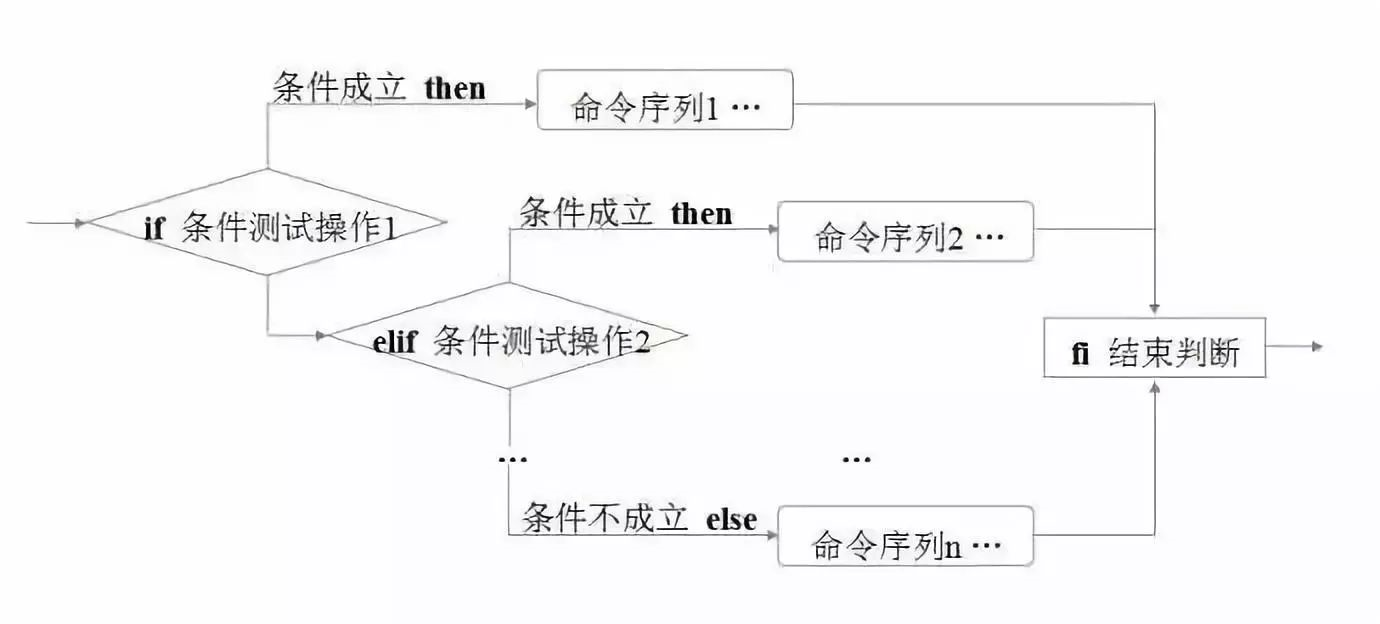if-then-else分支结构
if-then-else是一种基于条件测试结果的流程控制结构。如果测试结果为真,则执行控制结构中相应的命令列表;否则将进行另外一个条件测试或者退出该控制结构。
if-then-else语法格式:
if 条件1 then 命令列表1 elif 条件2 then 命令列表2 else 命令列表3 fi

执行逻辑流程图
说明:当条件1成立时,则执行命令列表1并退出if-then-else控制结构;如果条件2成立,则执行命令列表2并退出if-then-else控制结构;否则执行命令列表3并退出if-then-else控制结构。在同一个if-then-else结构中只能有一条if语句和一条else语句,eilf语句可以有多条。其中if语句是必须的,elif和else语句是可选的。
Shell脚本首先判断文件test1是否可读,如果是,则输出 is readable !的提示信息;否则不进行任何动作。
[root@localhost 20190105]# vi test.sh filename=test1 if [ -r $filename ] //输出test1可读则输出信息 then echo $filename' is readable !' fi [root@localhost 20190105]# sh test.sh test1 is readable !
Shell脚本会判断number变量是否等于100,如果是,则输出 The number is equal 100 !的提示;否则输出 The number is not equal 100 !。
[root@localhost 20190105]# vi number.sh number=200 if [ $number -eq 100 ] //如果number等于100则输出“The number is equal 100 !”提示 then echo 'The number is equal 100 !' else //否则输出“The number is not equal 100 !”提示 echo 'The number is not equal 100 !' fi [root@localhost 20190105]# sh number.sh The number is not equal 100 !
Shell脚本首先判断number变量是否小于10,如果是则输出 The number < 10 !;否则,判断number变量是否大于等于10且小于20。如果是则输出 10 =< The number < 20 !;否则,判断 number变量是否大于等于20且小于30。如果是,则输出 20 =< The number < 30 !;否则,输出 30 <= The number !。
[root@localhost 20190105]# vi number1.sh number=25 if [ $number -lt 10 ] //如果number小于10 then echo 'The number < 10 !' elif [ $number -ge 10 -a $number -lt 20 ] //如果number大于等于10且小于20 then echo '10 =< The number < 20 !' elif [ $number -ge 20 -a $number -lt 30 ] //如果number大于等于20且小于30 then echo '20 =< The number < 30 !' else //除上述3种情况以外的其他情况 echo '30 <= The number !' fi [root@localhost 20190105]# sh number1.sh 20 =< The number < 30 !
case分支结构
if-then-else结构能够支持多路的分支(多个elif语句),但如果有多个分支,那么程序就会变得难以阅读。case结构提供了实现多路分支的一种更简洁的方法。
case语法格式:
case 值或变量 in 模式1) 命令列表1 ;; 模式2) 命令列表2 ;; ... esac
case语句后是需要进行测试的值或者变量。Shell会顺序地把需要测试的值或变量与case结构中指定的模式逐一进行比较,当匹配成功时,则执行该模式相应的命令列表并退出case结构(每个命令列表以两个分号“;;”作为结束)。如果没有发现匹配的模式,则会在esac后退出case结构。
如下该脚本对number变量的值进行测试,与模式匹配的话,则输出相应的信息。
[root@localhost 20190105]# vi case.sh number=66 case $number in 33) echo 'The number is 33 !' //number 变量等于 33 ;; 44) echo 'The number is 44 !' //number 变量等于 44 ;; 55) echo 'The number is 55 !' //number 变量等于 55 ;; 66) echo 'The number is 66 !' //number 变量等于 66 ;; 77) echo 'The number is 77 !' //number 变量等于 77 ;; 88) echo 'The number is 88 !' //number 变量等于 88 ;; esac //结束 case 结构 [root@localhost 20190105]# sh case.sh The number is 66 ! //命令的输出结果
for循环结构
for循环结构可以重复执行一个命令列表,基于for语句中所指定的值列表决定是继续循环还是跳出循环。for循环在执行命令列表前会先检查值列表中是否还有未被使用的值,如有的话,则把该值赋给for语句中指定的变量,然后执行循环结构中的命令列表。如此循环,直到值列表中的所有值都被使用。
for循环结构语法:
for 变量名 in 值列表 do 命令1 命令2 命令3 ... done
-
以常量作为值列表
使用变量1、2、3、4、5、6作为值列表,for循环中只是简单的把值列表中的值进行输出。
[root@localhost 20190105]# vi for1.sh #!/bin/bash for n in 1 2 3 4 5 6 //循环读取 1-6 do echo $n done 由运行结果可以非常清楚的了解for循环的运行过程。 [root@localhost 20190105]# sh for1.sh 1 2 3 4 5 6
-
以变量作为值列表
值列表可以是一个环境变量。
[root@localhost 20190105]# vi for2.sh #!/bin/bash values="1 2 3 4 5 6" //对 values 变量赋值 for n in $values //循环读取 values 变量中的值 do echo $n done [root@localhost 20190105]# sh for2.sh 1 2 3 4 5 6
-
以命令运行结果作为值列表
Shell支持使用命令的运行结果作为for循环的值列表。在Shell中通过"`命令`"或者“$(命令)”来引用命令的运行结果。将会以ls命令的结果作为值列表。
[root@localhost 20190105]# vi for3.sh #!/bin/bash for n in `ls` //循环读取 ls 命令的输出结果 do echo $n //输出变量 n 的值 done [root@localhost 20190105]# sh for3.sh case.sh for1.sh for2.sh for3.sh HelloWorld.sh number1.sh number.sh test1 test2 test.sh
expr命令计算器
expr是一个命令行的计数器,用于加、减、乘、除运算。
[root@localhost 20190105]# expr 123 + 456 - 78 //123 加 456 减 78 等于 501 501 [root@localhost 20190105]# expr 9 * 8 //9 乘以 8 等于 72 72 [root@localhost 20190105]# expr 666 / 8 // 666 除以 8 等于 83 83
在循环结构中,expr 会被用作增量计算,初始值为10,每次使用expr增加加11/12。注意:这里使用expr命令时都使用的是反撇号,不是单引号。
[root@localhost 20190105]# number=10 [root@localhost 20190105]# number=`expr $number + 11` //对number变量的值加11 [root@localhost 20190105]# echo $number 21 [root@localhost 20190105]# number=`expr $number + 12` //对number变量的值加12 [root@localhost 20190105]# echo $number 33
while循环结构
while结构会循环执行一系列的命令,并基于while语句中所指定的测试条件决定是继续循环还是跳出循环。如果条件为真,则while循环会执行结构中的一系列命令。命令执行完毕后,控制返回循环顶部,从头开始重新执行直到测试条件为假。
while循环结构的语法:
while 条件 do 命令1 命令2 ... done
-
循环增量计算:是在while循环中使用增量计算,其运行结果如下。
[root@localhost 20190105]# vi while1.sh #!/bin/bash count=0 //将 count 变量置 0 #当 count 变量小于5时继续循环 while [ $count -lt 5 ] do #每循环一次,count 变量的值加1 count=`expr $count + 1` echo $count done [root@localhost 20190105]# sh while1.sh 1 2 3 4 5 [root@localhost 20190105]#
-
循环从文件中读取内容
现有一文件,保存了学生的成绩信息,其中第一列是学生名,第二列是学生的成绩。
[root@localhost 20190105]# vi students.log jake 85 tom 68 lucy 79 sam 95
现在要对以上文件中的学生成绩进行统计,计算学生的数量以及学生的平均成绩。通过 while read 语句读取变量 STUDENT 和 SCORE 的内容,然后在 while 循环中通过 expr 命令计算学生总数和学生总成绩,最后计算平均值并输出。执行该脚本时需要把 students.log 文件的内容重定向到 while2.sh脚本中。
[root@localhost 20190105]# vi while2.sh #!/bin/bash TOTAL=0 //将变量 TOTAL 置 0 COUNT=0 //将变量 COUNT 置 0 #循环读取数据 while read STUDENT SCORE do #计算总成绩 TOTAL=`expr $TOTAL + $SCORE` #计算学生数 COUNT=`expr $COUNT + 1` done #计算平均成绩 AVG=`expr $TOTAL / $COUNT` echo 'There are '$COUNT' students , the avg score is '$AVG [root@localhost 20190105]# sh while2.sh < students.log There are 4 students , the avg score is 81 [root@localhost 20190105]#
until循环结构
until是除 for 和 while以外的一种循环结构,它会循环执行一系列命令直到条件为真时停止。
until循环结构语法:
until 条件 do 命令1 命令2 ... done
until循环中读取用户输入的内容并显示到屏幕上,当用户输入的内容为 exit 时结束循环。
[root@localhost 20190105]# vi until1.sh #!/bin/bash xxx="" #当 ans 变量的值为 exit 时结束循环 until [ "$xxx" = exit ] do #读取用户的输入到ans变量 read xxx #如果用户输入的不是 exit 则输出用户的输入 if [ "$xxx" != exit ] then echo 'The user input is : '$xxx #否则退出循环 else echo 'Exit the script.' fi done [root@localhost 20190105]# sh until1.sh hello The user input is : hello welcome to HongKong! The user input is : welcome to HongKong! exit Exit the script. [root@localhost 20190105]#